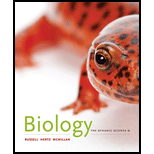
Concept explainers
Introduction:
Reproductive innovation is a phenomenon that involves the introduction of new devices or methods in the process of reproduction during the process of evolution. These innovations are also called as the adaptations, which were acquired by the organisms according to the changes in the surrounding environment.
Answer to Problem 1TYK
Correct answer:
The ovary.
Explanation of Solution
Justification/ Explanation for the correct answer:
Option (d) is, ‘the ovary’. The ovary only gives protection to the seed. It does not take part in the formation of a seed, so, it was not a part of the reproductive innovation related to seed evolution. Hence, option (d) is correct.
Explanation for the incorrect answer:
Option (a) is, ‘reduced female gametophyte’. The special characteristic of the non-vascular plants was the large and dominant gametophytes. These gametophytes became smaller and the sporophytes became larger and dominant as the plants evolved according to the variations present in the environment. They play a very important role in reproductive innovation and result in seed evolution. So, it is an incorrect option.
Option (b) is, ‘heterospory’. It involves the production of two different-sized spores, and from different sexes by the sporophytes of land plants. It is thought that the early plants (all
Option (c) is “the ovule.” The ovule is an important structure of the plant, which is converted into the seed after fertilization. The gymnosperms had uncovered ovules on the scales of the cone. The gymnosperms had the ‘naked seeds’, that is, their seeds were not covered by the ovary. Then, as time passed, the seeds adapted to the surrounding environment and became covered with the help of ovary. The seeds of
Option (e) is “the integument.” It is a protective layer which surrounds the ovule. The gymnosperms have only one integument present around the ovule but, in the angiosperms, there are two integumentary coatings present as an adaptation toward the changing environment. The integument later converts into the seed coat which provides protection to the seed to survive in unfavorable conditions. So, it is an incorrect option.
Hence, options (a), (b), (c) and (e) are incorrect.
Therefore, it can be concluded that the female gametophytes, heterospory, the ovule, and the integument participated in the reproductive innovation related to seed evolution. The ovary does not have any role in reproductive innovation.
Want to see more full solutions like this?
Chapter 29 Solutions
Biology: The Dynamic Science (MindTap Course List)
- What is behavioral adaptarrow_forward22. Which of the following mutant proteins is expected to have a dominant negative effect when over- expressed in normal cells? a. mutant PI3-kinase that lacks the SH2 domain but retains the kinase function b. mutant Grb2 protein that cannot bind to RTK c. mutant RTK that lacks the extracellular domain d. mutant PDK that has the PH domain but lost the kinase function e. all of the abovearrow_forwardWhat is the label ?arrow_forward
- Can you described the image? Can you explain the question as well their answer and how to get to an answer to an problem like this?arrow_forwardglg 112 mid unit assignment Identifying melting processesarrow_forwardGive only the mode of inheritance consistent with all three pedigrees and only two reasons that support this, nothing more, (it shouldn't take too long)arrow_forward
- Oarrow_forwardDescribe the principle of homeostasis.arrow_forwardExplain how the hormones of the glands listed below travel around the body to target organs and tissues : Pituitary gland Hypothalamus Thyroid Parathyroid Adrenal Pineal Pancreas(islets of langerhans) Gonads (testes and ovaries) Placentaarrow_forward
 Concepts of BiologyBiologyISBN:9781938168116Author:Samantha Fowler, Rebecca Roush, James WisePublisher:OpenStax College
Concepts of BiologyBiologyISBN:9781938168116Author:Samantha Fowler, Rebecca Roush, James WisePublisher:OpenStax College
 Biology (MindTap Course List)BiologyISBN:9781337392938Author:Eldra Solomon, Charles Martin, Diana W. Martin, Linda R. BergPublisher:Cengage Learning
Biology (MindTap Course List)BiologyISBN:9781337392938Author:Eldra Solomon, Charles Martin, Diana W. Martin, Linda R. BergPublisher:Cengage Learning Biology: The Dynamic Science (MindTap Course List)BiologyISBN:9781305389892Author:Peter J. Russell, Paul E. Hertz, Beverly McMillanPublisher:Cengage Learning
Biology: The Dynamic Science (MindTap Course List)BiologyISBN:9781305389892Author:Peter J. Russell, Paul E. Hertz, Beverly McMillanPublisher:Cengage Learning Biology Today and Tomorrow without Physiology (Mi...BiologyISBN:9781305117396Author:Cecie Starr, Christine Evers, Lisa StarrPublisher:Cengage Learning
Biology Today and Tomorrow without Physiology (Mi...BiologyISBN:9781305117396Author:Cecie Starr, Christine Evers, Lisa StarrPublisher:Cengage Learning





